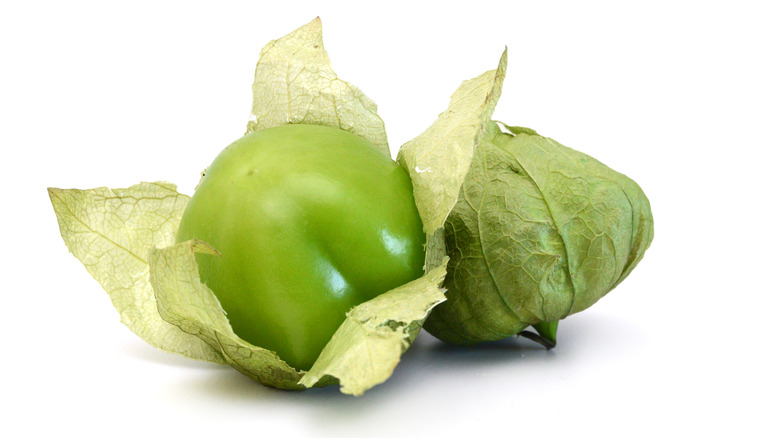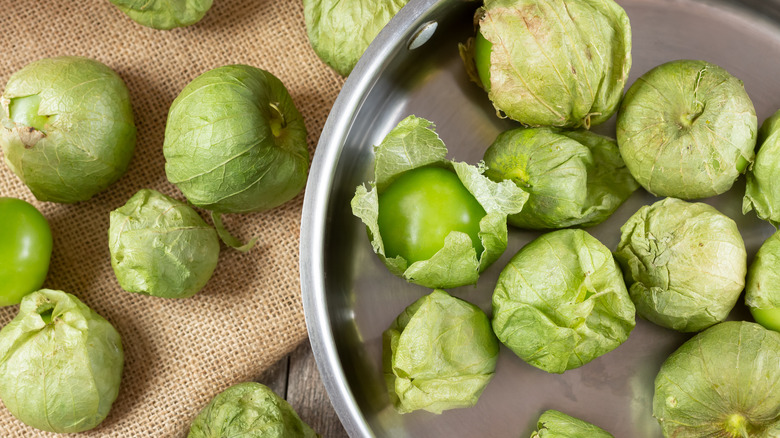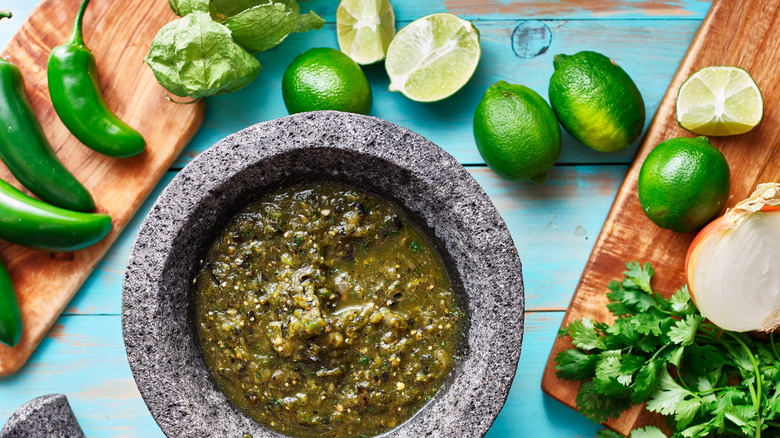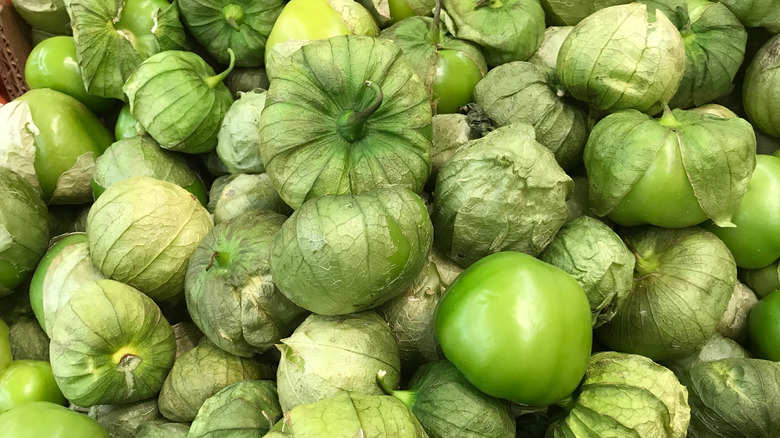Are Tomatillo Husks Actually Edible?
If you're not well acquainted with tomatillos, it's time to change that. While they can easily be mixed up with green tomatoes, it's important not to make that mistake! Tomatillos certainly stand on their own.
Technically, "tomatillo" means "little tomato," but they're much more than that. Tomatillos boast a bright, verdant shade and their flavor is tart, acidic, and piquant. Their taut green skin is sheathed in a papery husk, which can be varying shades of green or brown, and is almost reminiscent of a crisp, fallen autumnal leaf. These husks are a built-in protector, snugly encasing the viridescent fruit.
Tomatillo can also often have a subtle citrus-y note that offers a bright, subtle note underneath its puckering tartness — especially when eaten raw. They're small, circular, and there's often a stick layer of residue between the husk and the fruit. Just be sure to wash, scrub, or dry the fruit well to rid it of that stickiness prior to eating or further working with the fruit. Prior to being cooked, they are firm when pressed and very dense on the inside, with hardly any moisture or "give" when squeezed (via Mexican Please).
Here's everything else you need to know about tomatillos, including whether you can eat the husk.
What is the history of tomatillos?
ManyEats notes that the tomatillo has been grown, cultivated, and eaten throughout Central America for "centuries," primarily throughout Mexico and Guatemala. A tomatillo plant fossil was found to be 52 million years old (!) and originated from modern-day Argentina.
The tomatillo was immensely important to the diet and culture of the Mayans and Aztecs. In the 1500s and 1600s, the Spanish brought the plant to Europe, where it spread in popularity throughout many countries. It is thought that red tomatoes — being sweeter, larger, and much less tart — "caught on" and became consumed more often throughout Europe, which sidelined tomatillos culturally.
Fast-forward to the mid-1900s, when the tomatillo was then brought to India, and is now also being grown in Australia, South Africa, and even California, according to Britannica. What was once a staple fruit in the Central American diet has become a household ingredient for many.
What do you make with tomatillos?
Of course, tomatillo makes an exquisite salsa verde. If the tomatillo is deeply roasted or broiled until almost burnt prior to blending, the salsa is even better. Some also like to blend an avocado into the mixture, creating a salsa verde/guacamole hybrid of sorts. Delicious! They're also great in soups, pico de gallo, stews, sauces, moles, chutney, salsas, with varying proteins, and in many other applications (via Farmers' Almanac). Tomatillo is infinitely versatile, and can be enjoyed in multitude of was, from raw and roasted, to sautéed or even blanched, according to What's Cooking America.
As Farmers' Almanac notes, tomatillos are actually members of the nightshade family. Tomatillos may also be called husk tomato, husk cherry, or Mexican tomato. Skip any tomatillos with a dried out, shriveled husk — they're past their prime. Also, there's no need to peel the fruit or remove its seeds prior to eating or cooking.
And no, the husks are inedible and should certainly be removed before consuming tomatillo, according to What's Cooking America. Isabel Eats notes that some even say that the husk is actually poisonous — so definitely be sure to remove it fully and remove the sticky residue underneath prior to munching on a tomatillo.
Are tomatillos healthy?
Fresh tomatillos are by no means exorbitantly difficult to find or source, but some more limited supermarkets may not carry them. If you're unable to find fresh tomatillos, canned variations are also found in stores. If you're looking to grow your own, BHG has a super helpful primer here.
Nutritionally, tomatillo is incredibly good for you. They're high in vitamin C, K, niacin, potassium, manganese, and more beneficial nutrients, according to Farmers' Almanac. Men's Health notes that tomatillos also contain lutein and zeaxanthin, which help improve eye health. They're also high in dietary fiber, according to Brittanica. Clearly, tomatillos boast delicious flavor, nutritional benefits, great color, and a rich history — what's not to love? Their inclusion in salsa verde alone is enough to secure them a spot in the produce hall of fame.
We think red tomatoes have had their time in the sun ... pun intended? Give tomatillos a shot — we're pretty sure that you'll love them.



